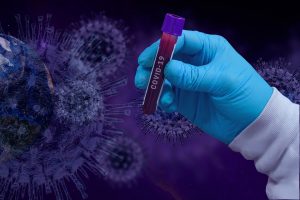Two years after infection, there is a continued risk of COVID. How can you evaluate your risk?
Two years after infection, there is a continued risk of COVID. How can you evaluate your risk?
The United Kingdom and coauthor Paul Harrison remarked, “These are important discoveries, but they shouldn’t lead to fear.” “We’re not discussing matters that occur 10 or 100 times more frequently. The worst odds ratio, in my opinion, is around two or three.”
Epilepsy or seizure diagnoses, encephalitis, and nerve root diseases, which can result in pain, numbness, and loss of feeling in a leg or an arm, are more common in children.
Additionally, there was a little bit concerning the chance of developing a psychotic condition like schizophrenia or delusional thinking.
The study’s findings corroborate Dr. Aaron Friedberg’s clinical observations, who is a clinical assistant professor of internal medicine and works in the Post-Covid Recovery Program at Columbus’ Wexner Medical Center.
Friedberg, who wasn’t a part of the research, said, “I recently spoke to someone who had been initially diagnosed with Covid more than two years ago, but they’re only seeing a post-Covid expert today.
“That does not necessarily imply that they are still experiencing those symptoms after two years. It implies that they have just recently received a diagnosis.”
Friedberg said that two years after diagnosis, he still encounters patients with significant symptoms. The research, which was released on Wednesday in the journal Lancet Psychiatry, examined hospital data from two years that included both adults and kids that were retrieved from the electronic health records network.
The study compared a closely matched group of 1.25 million persons who had a different respiratory illness to 1.25 million patients who had been diagnosed with Covid-19 two years earlier.
In the two years following Covid-19, According to coauthor Maxime Taquet, an academic clinical resident in psychiatry at the National Institute for Health and Care Research’s Biomedical Research Division, “we compared the two groups of patients in terms of 14 important neurological and mental diseases.” respiratory infection Center in the UK.
Anxiety disorders, mood disorders, psychotic disorders, insomnia, cognitive deficit (a composite of codes to capture “brain fog”), dementia, epilepsy or seizures, encephalitis, intracranial hemorrhage, stroke, parkinsonism, Guillain-Barré syndrome, nerve, nerve root, and plexus disorders, and neuromuscular and muscle disease were all examined by the research team. Researchers also examined fatalities due to any reason.
The majority of the participants in the research were Americans, although some came from Australia, the UK, Spain, Bulgaria, India, Malaysia, and Taiwan.
According to Taquet, the study was unable to determine if participants had continued symptoms for the whole two years following a Covid-19 diagnosis. “This data does not consider the persistence or duration of the symptoms; it merely examines the number of new diagnoses being made.”
Both good and negative news was revealed
When compared to persons with other respiratory problems, Taquet added that for adults, the chance of acquiring “brain fog, dementia, psychotic disorders, and epilepsy and seizures stay heightened over the two years.”
The study found that the likelihood of those over 65 receiving a dementia diagnosis increased. He said, “it’s fairly apparent that this is not a tsunami of new dementia cases, but rather a diagnosis of dementia and the catastrophic consequences that come with it. Equally (I think), it’s impossible to ignore it.”
Taquet said, “The risk of various diseases, in particular anxiety and mood disorders, diminished within two to three months, with no total increased number of cases during the two-year period.
Effect on young people
Additionally, there was good news for kids: According to Taquet, “the danger of brain fog in youngsters was temporary — there was no overall risk.” The chance of a kid receiving an anxiety or depression diagnosis decreased with Covid-19, “even in the first six months,” he claimed.
But when it came to other disorders, there were alarming findings. For instance, Taquet noted that children who received Covid had a “threefold increased risk” of being diagnosed with a psychotic disorder two years later compared to those who received a diagnosis of another respiratory tract infection. Children also had a “twofold increased risk” of epilepsy and seizures.
260 of the 10,000 kids in the study with the Covid-19 diagnosis experienced epilepsy and seizures within two years, whereas only 130 of the 10,000 kids with another respiratory infection experienced these symptoms, representing a “twofold increased risk,” according to Taquet.
Children two years after a Covid-19 infection had a threefold greater probability of being diagnosed with a psychotic condition, according to Taquet. Nevertheless, he noted that with just 18 documented instances of psychosis per 10,000 children, “the absolute risk remains relatively low.”
Paul Garner, an emeritus professor of evidence synthesis in global health at the Liverpool School of Tropical Medicine in the UK, remarked, “I think we need to be careful in the interpretation of the observed minor increases in dementia and psychosis.” Garner didn’t take part in the investigation.
A lasting effect
Overall, the study’s findings are “especially concerning,” according to Cardiff’s Sumner, because even Covid-19 variations thought to be milder seem to have the same long-term effects.
Additionally, Sumner noted that “some of these illnesses will continue to have delays in detection and treatment due to healthcare systems that are already struggling to manage Covid infections and backlogs of patient waiting lists.”
That fact is consistent with the clinical knowledge of medical professionals like Friedberg, who have been treating long-term Covid patients since shortly after the epidemic started.
“I have patients with severe post-Covid from the ancestor strain from March 2020, and I have the same in patients who very just developed it. So, I believe that any of these variations may have an equally harsh effect, “explained he.
According to Friedberg, “the thought that there may be this dreadful thing happening that we won’t realize until months or years later is not being handled sufficiently.
“Say youngsters simply can’t run as much as they used to, or adults just can’t perform as many job responsibilities, or they just have difficulties taking care of their kids at home because they just have brain fog, or they have chronic shortness of breath.”
The tranquil “pixel forest” by artist Pipilotti Rist examines the complexity of our digital life


1 comment